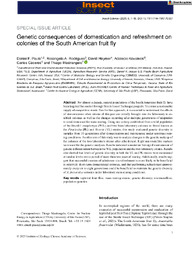Embrapa Grape & Wine
Genetic consequences of domestication and refreshment oncolonies of the South American fruit ?y
Author(s): PAULO, D. F.; RODRIGUES, R. A.; HAYMER, D.; KOVALESKI, A.; CÁCERES, C.; MASTRANGELO, T.
Summary: For almost a decade, natural populations of the South American fruit fly havebeen targeted for control through Sterile Insect Technique projects. To ensure a sustainablesupply of competitive sterile flies for this approach, it is essential to understand the effectsof domestication when strains of this pest are initially brought into the laboratory to es-tablish colonies as well as the changes occurring after multiple generations of adaptationto conditions used for mass rearing. Using one colony established from a wild populationof the Brazil-1 morphotype (WIL) and two from laboratory colonies in Brazil known asthe Piracicaba (PL) and Vacaria (VL) strains, this study evaluated genetic diversity insamples from 10 generations after domestication and maintenance under semimass rear-ing conditions. Another aim of this study was to analyze changes in the genetic makeup ofthe colonies of the two laboratory strains after refreshment. Eight microsatellite markerswere used for the genetic analyses. Results indicated a moderate but significant amount ofgenetic differentiation between the WIL population and the two laboratory strains. Resultsalso showed that levels of genetic diversity in both the VL and PL strains were maintainedat similar levels over a period of more than two years of rearing. Additionally, results sug-gest that successful creation of admixture via refreshment is more likely to be beneficialin relatively short-term domesticated colonies, and that performing refreshment approxi-mately every six to eight generations could be beneficial to maintain the genetic diversityof A. fraterculus colonies under laboratory mass rearing conditions
Publication year: 2025
Types of publication: Journal article
Unit: Embrapa Grape & Wine
